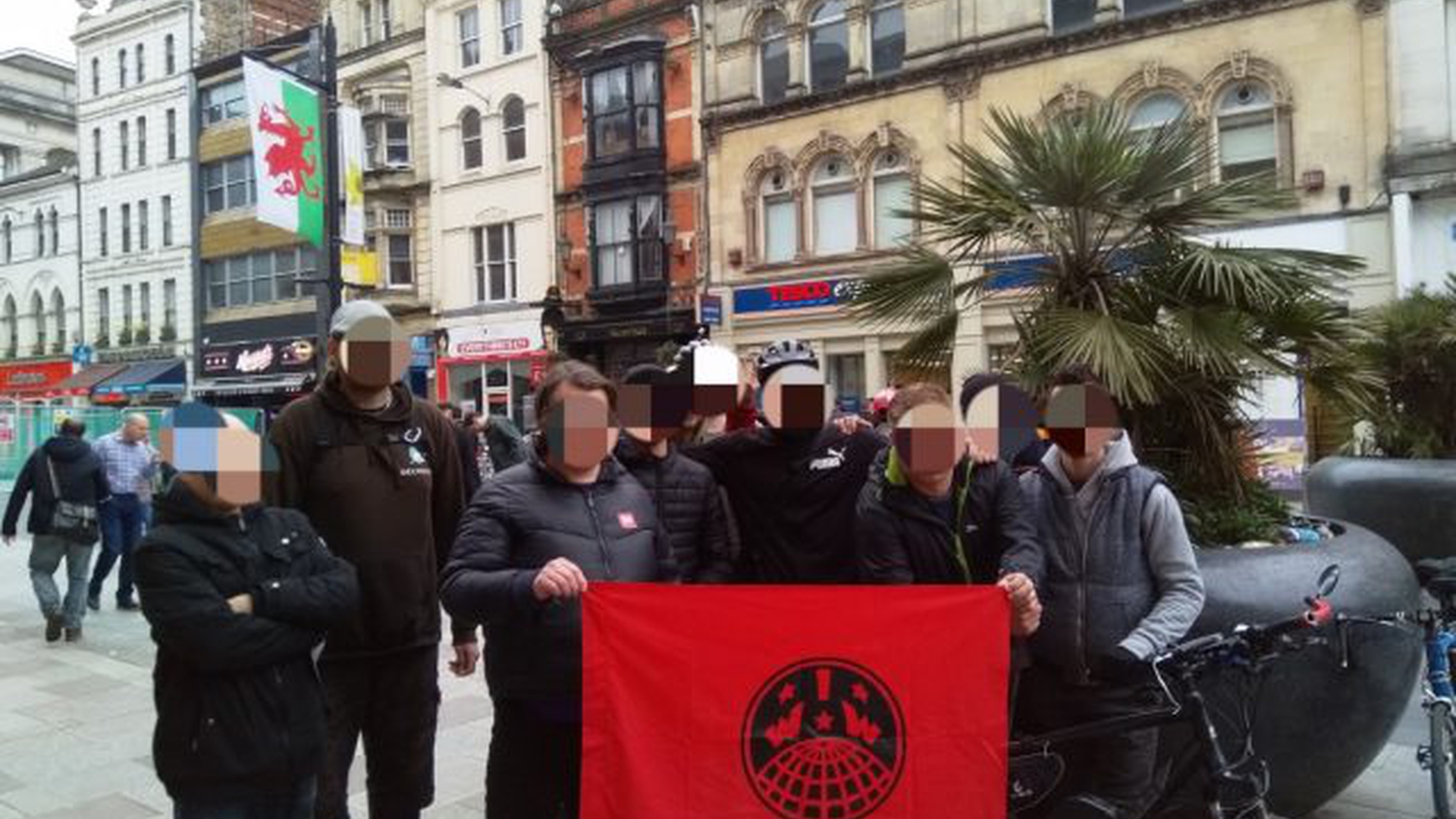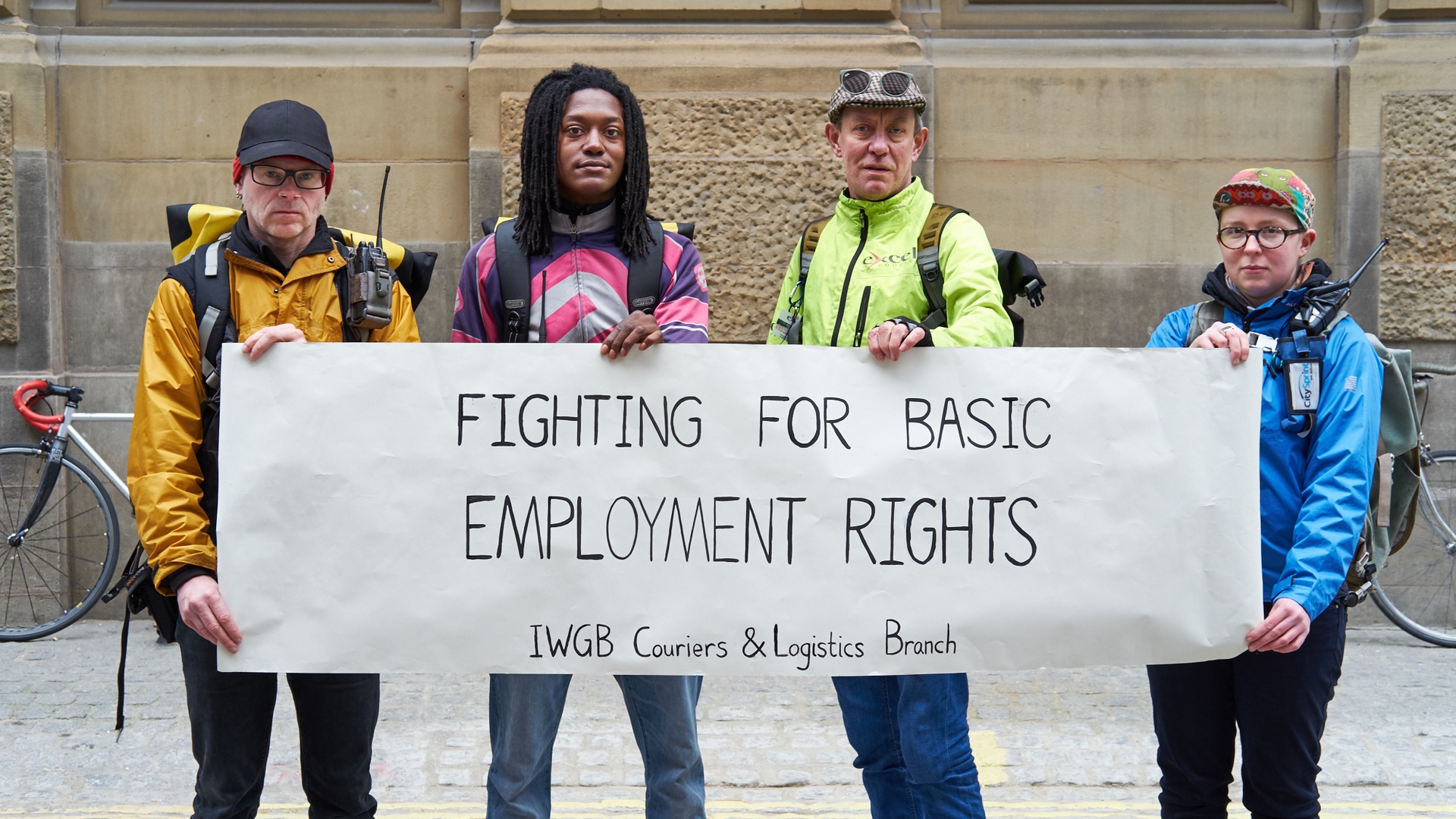The Workers Will See You Now: Organising with the IWGB
by
Jim Benfield
August 16, 2018
Featured in The Worker and The Union (#3)
Medical Couriers organising with the grassroots union, the Independent Workers Union of Great Britain
inquiry
The Workers Will See You Now: Organising with the IWGB
by
Jim Benfield
/
Aug. 16, 2018
in
The Worker and The Union
(#3)
Medical Couriers organising with the grassroots union, the Independent Workers Union of Great Britain
Couriers in the IWGB (Independent Workers Union of Great Britain) at The Doctors Laboratory (TDL), a pathology services contractor with its own courier workforce, are at an important juncture in their pay rise campaign. TDL couriers have just received an offer from the bosses that failed to address their key demands: a proper pay rise, and an end to an unequal pay structure that is characteristic of the courier industry and detrimental to worker solidarity. This most recent offer had been earmarked as a turning point: it had been decided that a lacklustre proposal would trigger a campaign of direct action. The workers are now going to debate the proposal and vote on how to proceed.
What has characterised this campaign so far? Where does it fit in the landscape of organised labour? How is it different from other campaigns that the IWGB couriers branch has waged, and how do the union and the workers relate to each other? Who are the couriers and how have they changed since making contact with the union? In order to try and answer these questions, I have employed the workers’ inquiry approach. I designed a survey (which can be found below), which I presented to four people: one official and the three main organisers.
Class composition
To begin with, a word on the social and technical composition of the workforce. These workers are all men from the ages of 30 to 65. There is low turnover, with some workers having spent decades at the same company. The workforce is divided primarily into two groups: motorbikes and pushbikes. There are also walkers and van drivers. Motorbikes are the biggest group. These blocks are further divided by employment category, from full PAYE employees to independent contractors (although this has changed during the campaign and the self-employed workers are now classified as ‘limb (b) workers’). The pay structure is mixed throughout these categories, from fixed salary to piece-rate circuit work and daily guarantees. This division is, of course, detrimental to worker solidarity: it pitches workers against each other by creating a hierarchy of earnings. What’s more the income hierarchy is opaque and as such creates an environment where rumours abound of who earns more, who does the most work, whether they deserve the money and so on. The different modes of transport also create divisions in the workforce, where van drivers are more likely to hang out with van drivers, pushbikes with pushbikes, and so on. The divisions this technical composition create have been broken down as the workforce has become more organised (more on which later).
There is a large segment of Brazilian workers, who are a familiar part of the courier landscape these days and whose militancy has been crucial to other recent strikes in this industry, notably in the Deliveroo strikes in Brighton and London1. Once again migrants are proving to be an essential foundation of organised labour in this country.
There is a direct link between this campaign and the first campaign waged by the CLB, in that one of the main organisers took part in these early actions by occupying and leafleting during the protests (more on these shortly). This organiser was the first to make contact with the union.
There are some clear cultural components at play in the foundations of the campaign. The early IWGB CLB campaigns involved pushbikes, and it was the pushbikes who were the first to sign up in this workplace, along with a small number of motorbike drivers. Pushbike couriers have a strong community: they constitute a subculture, replete with a recogniseable fashion sense. The IWGB has some cultural capital amongst the pushbike courier community, which is hard to quantify but can been illustrated by the award of the Marcus Cook ‘Services to the International Courier Community’ prize in 2016 and a recent donation from the London Courier Emergency Fund, an icon of the London courier scene.2 The union being recognised and having an identity within this culture has played a role here in spreading resistance and organisation in the industry.
What’s more, the Brazilian segment of the workforce reveals a cultural link between this campaign and that of otherwise distinct campaigns, such as those of Deliveroo couriers. Whilst the IWGB is a link here too, it is important to remember that the campaigns in London and Brighton began as wildcat strikes championed, especially in Brighton, by Brazilian motorbike couriers. These campaigns have been greatly helped by a culture of militancy imported by Brazilian workers. The IWGB itself, of course, has its roots in a culture of militancy imported from Spanish speaking Latin America.3 This is yet more evidence of the overwhelmingly pivotal role migrants are playing in contemporary working class organisation.
This campaign has taken a “slowly, slowly” approach
The Couriers and Logistics Branch (CLB) put itself on the map a few years ago, when a group of couriers organised with the IWGB for the first time and targeted high profile courier clients, such as The Guardian, in their campaign for the London Living Wage. This pay rise campaign, which was a cross-workforce collaborative campaign across a number of different companies, will be known to observers for its relatively quick movement to direct action. This campaign has been one of many (such as the ‘3 cosas’ campaign and the current ‘Back in House campaign’ at University of London) that has led the IWGB to become characterised by many as a militant, campaigning union.
At TDL, however, it has been more than 18 months since ‘first contact’ with the IWGB. A group of couriers approached the IWGB after pay cuts (only the tipping point for a workforce routinely exploited and ignored by their bosses) and they became part of a package of ‘worker status’ cases that the IWGB had already launched in the ‘big four’ courier companies.4 These cases sought to challenge the bogus self-employment model that characterises the courier industry, and now famously characterises the so-called ‘gig-economy.’
Over that time the IWGB has launched a number of legal challenges at TDL: a back-dated holiday claim (seeking to rectify decades of bogus employment classification) that values £1.2m; a union recognition agreement that TDL eventually signed after months of teasing; and negotiations for full employee status that some TDL couriers have now won. These legal challenges have formed the backdrop to a recruitment campaign. A very significant number of workers are now members of the union, and numbers grow with each victory the legal challenges have won: 28 days holiday pay a year, employee status, the promise of a huge cash payout, and the ability to negotiate with the bosses.
The campaign is not overtly political
One interesting note about the organisers at TDL and the way they describe the workers is that there is no overt political dynamic at play in the campaign. This is perhaps typical of IWGB campaigns, which aside from being rooted in a fundamental ‘workers/bosses’ dynamic tend not to be pedagogical or to prescribe any one kind of politics on the campaign. None of the organisers describe themselves as inherently political beings. Even the IWGB, despite its militant left-wing image, is not really described as such by officials or by the organisers. Two of the organisers I spoke to refute politics altogether. One describes himself on a journey of politicisation. It is clear at TDL that there is in fact a broad spectrum of political opinion, but when asked about how politics or political discussions feature in the workplace I got the same answer: ‘…uh, they don’t, really.’
A journey is most definitely underway, in that an understanding of the fundamentals of working class power is emerging amongst the organisers, and amongst the workforce as a whole. When I asked L, who had never been in a union before, what he had learned over his time as an organiser, he told me that ‘when we unionise, we have power.’ This sentiment is shared amongst all of the organisers, who repeated, nearly verbatim, that ‘we have power now; they listen to us now - or, they have to listen.’
Conciliation to direct action: natural growth?
The campaign has, from the start, aimed at introducing a framework for negotiation into the workplace. All of the organisers characterised some of the main problems at work as stemming from being ignored by managers, and they also identify the ability to negotiate with the bosses as one of the biggest victories. A lack of understanding of, and proper respect for, the work that these couriers do is seen as one of the major problems: ‘We need to educate them, we need to show them what it is we do.’
There is still some hope amongst the organisers that they will be able to negotiate their demands from management. And yet at this point trust in the bosses is at rock bottom, not just amongst the main organisers but in the workforce as a whole: ‘it’s an us and them relationship.’ At first the successes of the campaign were about finally being heard - the victory of establishing links to Human Resources (HR) and a presence at meetings with the CEO was enormous and brought pride to a workforce routinely trodden on by their bosses, as well as a route to actually resolving individual issues with management. But after all this time, direct action has come into the picture in a way that many of the organisers once thought was impossible. This is unanimously described as natural growth: ‘at times we’ve been pretty grateful for our presence at the meetings, but that was naive. They’re the ones that should have been grateful. They haven’t respected that… we’ve been very patient and they haven’t given us the respect we deserve.’ X is describing a shift in the balance of power, one that is palpable in the workplace, and one that is rooted in a growing awareness of the power that the workers have now that they are organised.
This is an interesting dynamic revealed in the unionisation of a workforce where previously there was no proper organisation. The union has played a role in eroding trust in managers, even as it has pursued a conciliatory approach that has been enthusiastically endorsed by the organisers and many in the workforce. This has happened for two reasons. Firstly, because ‘the management have exposed themselves’ (as the IWGB official put it). Despite making progress in the negotiations, management have repeatedly union baited, sidestepped, backtracked, misled and generally frustrated the good intentions of the workers. And secondly, because during this time worker power has increased. Now the workers are intimately aware of the fact that without their labour, there is no business: power is in their hands.
The appetite for direct action has been increasing over the past month as the workers waited for the most recent proposal from their bosses. When questioned on the “slowly, slowly” approach that has been taken in this campaign, nearly all the organisers say it has been ideal for their situation. Over this time the community amongst workers has grown. Membership numbers have skyrocketed and their strong numbers have given the organisers confidence and a sense of the power of organised labour. ‘It wouldn’t have been possible a year ago. Couriers are very independent. We didn’t have the numbers. Now when I see demonstrations I think, I can see all us doing that. Placards, flyers, speeches - it’s achievable.’
Leadership is not a dirty word
The approach to tactics and organisation can generally be characterised as top down. At first the branch officials played a strong role in organising and recruitment. This has now diminished as the workplace organisers have gained experience and confidence, and they themselves have taken leadership roles amongst their fellow workers. This is now bleeding into the creation of a new line of organisers who are neither reps nor officials, although this is taking time. But the branch officials and central union still play a strong role in orchestrating the campaign tactically. All of the organisers turn to the union for advice and for leadership: ‘We’re like an advice bureau.’ They are learning the ropes for the first time and are comfortable with the directing role played by the central union, who they see as a body of experience in running campaigns and winning them.
On the other hand, the communication path between members, reps, and officials is very responsive and appears to function without any complaint of misrepresentation, or any report of a divide between the tactics suggested by the union and the demands of the members and organisers. In fact, when asked about whether they ‘identified’ with the union these organisers reported a strong connection with the union. Such a sense of identity with the union is an almost laughable concept for members of the bigger, more established unions. To a certain extent this sense of identity must come from the small scale of the operation. All of the organisers, and many of the workers, have met or have been in contact with all of the relevant officials up to the General Secretary of the union. This contact helps establish trust, and creates a sense of identity. It probably helps that the branch officials are also couriers, not full-time paid union workers: there is no suspicion that the officials don’t care, or don’t get it.
On top of this the internal dynamics within the membership are relatively simple. There is only one workplace, all the workers see each other face to face all the time, and they are part of the same chat groups, of which there are three: one for reps and officials, one for all members, and one for all member non-union chat. They are all active, and all created with the union to aid organisation. This has helped iron out the divisions that existed in the workplace before: organising together has ‘increased the sense of unity’. There is a sense of comradeship amongst the workers now which has been established through the process of organising, where they meet and discuss problems, which reveal themselves as collective issues. Importantly, no managers are represented so there is no conflict of interest within the membership. Compare all this to the recent ‘big union’ activity such as the pension strike at UCU: nationwide, multi-workplace, multi-tiered workforce, no previously established communication networks and a clear conflict of interest between the membership and high-up officials. There are fewer hurdles to organising when the jigsaw is so much smaller (corruption doesn’t help though).
Conclusion
This campaign has taken an approach of moving slowly towards direct action via the winning of a number of victories in the courts and at the negotiating tables. This style has come to characterise the CLB. It perhaps finds a good home in precarious workforces that have had such a bleak absence of proper organisation for so long: conditions are so bad they are actually illegal, and can be challenged in the courts. The amount that has been won before any direct action has been pursued is shocking.
There are clear cultural links between this campaign and other recent struggles that show how organised working class resistance is spreading, not just in the courier industry but also in the union movement as a whole. The union becoming recognised within the pushbike courier community has been important. The role of migrant workers ties this campaign not just to other courier campaigns but also to other branches of the IWGB and its sister union the United Voices of the World, another migrant-led union in London, which have produced some of the best victories in the union movement over the past few years.5 And yet the composition of this workforce is different, made up of as it is by largely motorbike couriers at a workforce with low turnover. It is for us to see how the struggle develops from here, and where it might spread.
Since first contact with the union the organisers, who previously had no union experience and broadly do not identify as ‘political’ people, have made a journey towards a class consciousness that is intimately aware of the power of organised workers. It is no surprise that ‘an end to unequal pay’ has become one of the central demands of the campaign, and this is testament to the solidarity that has been fostered in the workforce over the time that it has been unionised. It goes to show how wrong it is to ignore precarious workforces - ‘the unorganiseable’ - and yields a bit of hope for a union movement so often unable to cultivate confidence in the power of organised labour.
Watch this space to see how the organised couriers at TDL respond to the proposal from the bosses. You can look for updates on the IWGB CLB’s social media feeds.6
Photo for the article Selim Korycki
Featured in The Worker and The Union (#3)
author
Jim Benfield
Subscribe to Notes from Below
Subscribe now to Notes from Below, and get our print issues sent to your front door three times a year. For every subscriber, we’re also able to print a load of free copies to hand out in workplaces, neighbourhoods, prisons and picket lines. Can you subscribe now and support us in spreading Marxist ideas in the workplace?
Read next

Rebel Roo Bulletin
by
Rebel Roo
/
Aug. 16, 2018


